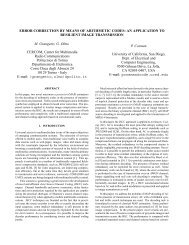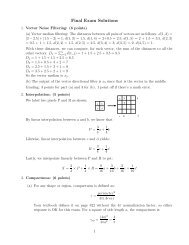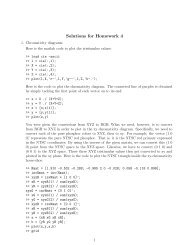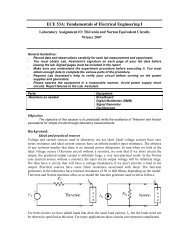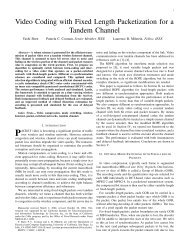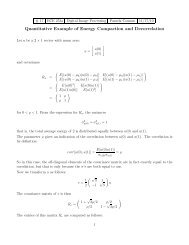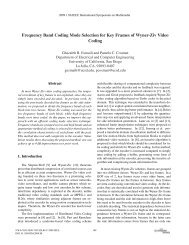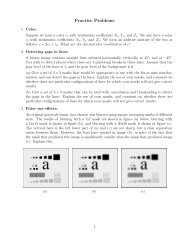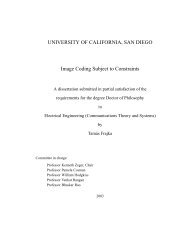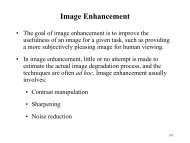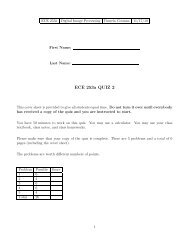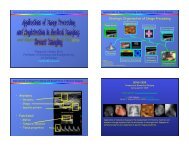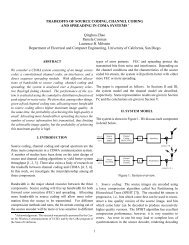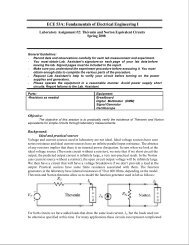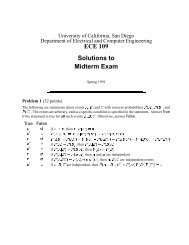Dual frame motion compensation for a rate switching - Information ...
Dual frame motion compensation for a rate switching - Information ...
Dual frame motion compensation for a rate switching - Information ...
Create successful ePaper yourself
Turn your PDF publications into a flip-book with our unique Google optimized e-Paper software.
<strong>Dual</strong> <strong>frame</strong> <strong>motion</strong> <strong>compensation</strong> <strong>for</strong> a <strong>rate</strong><br />
<strong>switching</strong> network<br />
Vijay Chellappa, Pamela C. Cosman and Geoffrey M. Voelker<br />
Dept. of Electrical and Computer Engineering, Dept. of Computer Science and Engineering<br />
University of Cali<strong>for</strong>nia, San Diego La Jolla, CA 92093-0407<br />
Email: {vchellap, pcosman}@ucsd.edu,voelker@cs.ucsd.edu<br />
Abstract-Standard video coders often use the im-<br />
mediate past <strong>frame</strong> as a reference <strong>frame</strong> with <strong>motion</strong><br />
<strong>compensation</strong> <strong>for</strong> video encoding. In this paper, we<br />
use dual reference <strong>frame</strong> <strong>motion</strong> <strong>compensation</strong> in the<br />
context of high bandwidth to low bandwidth <strong>switching</strong><br />
such as from an Ethernet connection to a GPRS<br />
system. The implementation is based on MPEG-4.<br />
Simulation results show that there is a significant gain<br />
in the PSNR <strong>for</strong> relatively static video sequences.<br />
I. INTRODUCTION<br />
Standard video coders use temporal coding with<br />
<strong>motion</strong> <strong>compensation</strong> to achieve compression gains.<br />
This is based on the assumption that the past <strong>frame</strong> is<br />
highly correlated with the current <strong>frame</strong>. We propose<br />
to use dual <strong>frame</strong> <strong>motion</strong> <strong>compensation</strong> in wireless<br />
network settings that experience significant transi-<br />
tions in network capacity, such as those produced<br />
by network handoffs while using services such as<br />
Always Best Connected (ABC) [I].<br />
A. The ABC network<br />
With the widespread use of wireless access net-<br />
works and the deployment of 3G services, connec-<br />
tivity service to the Internet with mobile devices<br />
such as PDAs and laptops needs to be maintained.<br />
The ABC service assists the user by automatically<br />
handling selection of access networks based on net-<br />
work availability and user preferences. Table I shows<br />
the various access networks supported by the ABC<br />
service.<br />
The ABC network provides the <strong>frame</strong>work <strong>for</strong> a<br />
user who wants to connect to a service to be able<br />
to choose network access and devices in a way that<br />
best suits his or her needs, and to change networks<br />
when something better becomes available.<br />
0-7803-8104-1/03/$17.00 02003 IEEE 1539<br />
Wireless Access Network I Bandwidth<br />
WLAN I IlMbps - IGbps<br />
Ethernet IOMbps<br />
500kbps<br />
IxRTT 64kbDs<br />
GPRS<br />
ldkbps<br />
TABLE I<br />
NETWORKS SUPPORTED BY THE ABC FRAMEWORK<br />
B. Duuljkme <strong>motion</strong> <strong>compensation</strong><br />
In multiple <strong>frame</strong> prediction, the encoder uses<br />
more than one reference <strong>frame</strong> <strong>for</strong> <strong>motion</strong> compen-<br />
sated prediction. A dual <strong>frame</strong> encoder is a special<br />
case of a multiple <strong>frame</strong> encoder, in which two<br />
<strong>frame</strong>s are used <strong>for</strong> <strong>motion</strong> <strong>compensation</strong>; they are<br />
often called the short-term past <strong>frame</strong> and the long-<br />
term past <strong>frame</strong>.<br />
The idea of using a long-term past <strong>frame</strong> as an<br />
additional reference <strong>frame</strong> <strong>for</strong> <strong>motion</strong> <strong>compensation</strong><br />
was considered in several papers [2], [3], [4], [SI as<br />
well as in the recent H.264 standard. [2] is one of the<br />
earliest papers to employ multiple <strong>frame</strong>s <strong>for</strong> <strong>motion</strong><br />
<strong>compensation</strong> to reduce the number of bits required<br />
to code the difference signal. Substantial coding<br />
gains were reported. In [3], a multi-<strong>frame</strong> extension<br />
was proposed to the single <strong>frame</strong> reference temporal<br />
coding. This was shown to yield improved com-<br />
pression efficiency because of the extended search<br />
provided by additional <strong>frame</strong>s <strong>for</strong> Block Motion<br />
Compensation, It was further shown that this multi-<br />
<strong>frame</strong> extension was robust to wireless channel<br />
losses, where the channel was modelled as a multi-<br />
state Markov chain. Error resilience was obtained<br />
by randomly choosing among the stored <strong>frame</strong>s
"-D a-1<br />
I II I<br />
High Rate<br />
Connection (IO Mbpr)<br />
used in multi-<strong>frame</strong> coding. In [4], the concept of<br />
the dual <strong>frame</strong> was simulated in a low bandwidth<br />
situation by Motion Compensated prediction using<br />
block partition prediction and utilization of two time<br />
differential reference <strong>frame</strong>s. The coding scheme was<br />
found to improve the quality of object boundaries.<br />
Means <strong>for</strong> controlling the time delay involved in<br />
transmitting the <strong>motion</strong> vectors as side in<strong>for</strong>mation<br />
were presented in [5]. A <strong>rate</strong> constrained <strong>motion</strong><br />
estimation method was employed to control the bit-<br />
<strong>rate</strong> of the <strong>motion</strong> vector coding which may become<br />
prohibitively large <strong>for</strong> low bandwidth situations. The<br />
issue of using multiple <strong>frame</strong> <strong>motion</strong> <strong>compensation</strong><br />
in the context of optimal interhtra mode selection<br />
within a <strong>rate</strong> -distortion <strong>frame</strong>work .was studied in<br />
[6]. It was shown that the above method improves<br />
the compression per<strong>for</strong>mance of the coder.<br />
In contrast'to previous work, we propose to use<br />
the dual <strong>frame</strong> concept in wireless network settings<br />
that experience significant transitions in network ca-<br />
pacity, such as those produced by network handoffs<br />
while using services lie Always Best Connected<br />
(ABC) [I]. By using dual <strong>frame</strong> encoding in this<br />
context, the system can significantly improve the<br />
quality of <strong>frame</strong>s transmitted immediately after the<br />
network handoff and smooth the' abrupt and severe<br />
transition in network capacity.<br />
Low Rae<br />
Connection (10-20 kbps)<br />
Fig. 1. <strong>Dual</strong> Frame Encoder schematic<br />
1540<br />
11. METHODOLOGY<br />
In our approach, the long-term past <strong>frame</strong> is<br />
assigned to be the last <strong>frame</strong> coded just prior to<br />
the network <strong>switching</strong> from the high bandwidth to<br />
the low bandwidth mode, as illust<strong>rate</strong>d in Figure 1.<br />
For each MacroBlock (MB) in a predictive Frame, a<br />
search is conducted over both the immediate past and<br />
the long-term past <strong>frame</strong>s, and the better matching<br />
block is chosen.<br />
A video encoder operating under services like<br />
ABC must be robust to bandwidth changes of multiple<br />
orders of magnitude. We assume that the ABC<br />
network provides a timely delivery of packets with<br />
minimal loss. To counter the huge swings '& bandwidth,<br />
we assume that the quantization parameter <strong>for</strong><br />
each <strong>frame</strong> can be varied over its full range (1-31)<br />
as opposed to a standard compliant encoder which<br />
restricts the change in the quantization parameter<br />
value to 25% of the previous value.<br />
To evaluate the effectiveness of the dual <strong>frame</strong><br />
buffer technique, we simulated it by modifying the<br />
standard MF'EG-4 coder. The MPEG-4 coder uses<br />
the <strong>rate</strong> control method employed in [7]. We considered<br />
each <strong>frame</strong> as a single object <strong>for</strong> the MPEG-<br />
4 encoder. We allocated additional memory <strong>for</strong> the<br />
long term <strong>frame</strong>. An extra bit is transmitted per .~<br />
inter coded MB to in<strong>for</strong>m the. decoder which <strong>frame</strong> . . .<br />
it referenced. The intra refresh period was set to<br />
-. .
100. Lowering the intra refresh period enhanced the<br />
per<strong>for</strong>mance of the dual <strong>frame</strong> encoder. But frequent<br />
intra refresh results in higher bit <strong>rate</strong>s which would<br />
exceed the bit <strong>rate</strong>s available <strong>for</strong> a GPRS system.<br />
As inputs to the simulator, we used the News, Con-<br />
tainer and Foreman sequences. The News sequence<br />
consists of periodic background changes with news<br />
readers in the <strong>for</strong>eground. Because the <strong>for</strong>eground<br />
is fairly static, we expect the dual <strong>frame</strong> buffer to<br />
be effective <strong>for</strong> the <strong>for</strong>eground <strong>for</strong> some time after<br />
the <strong>rate</strong> drop occurs. Also, the background shows a<br />
dancer who revolves around; the dancer returns to<br />
the starting position and then repeats, so we expect<br />
the dual <strong>frame</strong> encoder to per<strong>for</strong>m well <strong>for</strong> this<br />
repeating background. To investigate the effect of<br />
scene changes, we used the Foreman sequence. This<br />
sequence shows a man talking in a fairly static back-<br />
ground with a scene change towards the end. The<br />
Container sequence depicts a ship moving slowly in<br />
the ocean and we used this to see the effect of having<br />
no significant background change.<br />
The <strong>for</strong>mat of the test sequences is QCIF . The<br />
<strong>frame</strong> <strong>rate</strong> was 10 <strong>frame</strong>s/second. To investigate the<br />
effects of <strong>switching</strong> to different low bandwidth net-<br />
works, we simulated <strong>switching</strong> from 1 Mbps to low<br />
bandwidth networks ranging from IO kbps (GPRS)<br />
to 150 kbps (1xRTT CDMA). We encoded each of<br />
these sequences using our dual <strong>frame</strong> buffer coder<br />
as well as with a conventional MPEG-4 coder <strong>for</strong><br />
comparison.<br />
111. DISCUSSION OF RESULTS<br />
Figures 2 through 7 show the results of the dual<br />
<strong>frame</strong> buffer simulation. The high bit <strong>rate</strong> <strong>for</strong> all of<br />
the plots shown is 1 Mbps. The low bit <strong>rate</strong> <strong>for</strong> the<br />
plots in Figures 2, 4, and 6 is 16 khps, and the low<br />
bit <strong>rate</strong> <strong>for</strong> Figures 3, 5, and 7 is variable as depicted<br />
on the x-axis.<br />
Figure 2 shows the PSNR (in dB) <strong>for</strong> each decoded<br />
<strong>frame</strong> of the News sequence, <strong>for</strong> the MPEG-4<br />
standard coder and the dual <strong>frame</strong> encoder. Figure<br />
3 is a plot of the difference in PSNR between the<br />
standard MPEG-4 coder and the dual <strong>frame</strong> coder as<br />
the <strong>rate</strong> is changed <strong>for</strong> the News sequence.<br />
The News sequence shows gains primarily after<br />
the 150th <strong>frame</strong> because, when the dancer returns<br />
to the starting position, the background of the image<br />
closely matches the long term reference background.<br />
This is witnessed by the sharp spike at <strong>frame</strong> 150<br />
1541<br />
Fig. 2. PSNR versus <strong>frame</strong> number <strong>for</strong> the News sequence.<br />
Fig. 3. Average difference in PSNR between the dual <strong>frame</strong><br />
coder and the standard coder as a function of the bit <strong>rate</strong> of the<br />
low <strong>rate</strong> connection <strong>for</strong> the News sequence.<br />
in the News sequence (Figure 2). This gain in<br />
PSNR propagates to subsequent <strong>frame</strong>s and hence<br />
the decoded quality remains higher <strong>for</strong> the dual <strong>frame</strong><br />
encoder. Figure 3 shows the difference in PSNR<br />
(PSNR <strong>for</strong> the dual <strong>frame</strong> encoder minus PSNR <strong>for</strong><br />
the conventional single <strong>frame</strong> encoder) <strong>for</strong> the News<br />
sequence, as a function of the bit <strong>rate</strong> of the low
=<br />
e<br />
* i";<br />
31 . . . . . . . . . .. . . . . . , . .. .. .. . .. . . . . . . . . . . . . .. . ., . . . . . . . . . . . . . . . . . . . . . . . . . . . . . . . .<br />
...: ' ...,.. ........' .........' . . . . . . . . . .. .. .<br />
. . . . . . .. . . . . .. .. . .. .<br />
Fig. 4. PSNR versus <strong>frame</strong> number For the Foreman sequence.<br />
<strong>rate</strong> connection. For this plot, the PSNR is averaged<br />
over the 300 <strong>frame</strong>s in the sequence. The PSNR gap<br />
diminishes as the low <strong>rate</strong> connection has increasing<br />
<strong>rate</strong>.<br />
Figures 4 and 5 are analogous to Figures 2 and<br />
3, but <strong>for</strong> the Foreman sequence. This sequence<br />
initially shows gains of around 1 dB in PSNR. The<br />
gain disappears completely towards the end of the<br />
sequence (around <strong>frame</strong> 275) because of a change in<br />
the background. The Container sequence (Figures 6<br />
and 7) shows similar results. The initial gains are<br />
substantial, but the value of the long term <strong>frame</strong><br />
diminishes over time. As expected, the PSNR gains<br />
in Figuse 7 decrease as the <strong>rate</strong> of the low bandwidth<br />
connection increases.<br />
.,<br />
IV. CONCLUSION<br />
In this paper, we presented a dual <strong>frame</strong> buffer<br />
<strong>motion</strong> <strong>compensation</strong> system used to. improve video<br />
quality after network handoffs in services like ABC<br />
when they switch from a high data <strong>rate</strong> to a low<br />
<strong>rate</strong>. We evaluated the technique on three video<br />
sequences that vary in their characteristics. We found<br />
that retaining the high quality <strong>frame</strong> to be used as<br />
the long term ,past <strong>frame</strong> <strong>for</strong> the dual <strong>frame</strong> encoder<br />
results in better video quality <strong>for</strong> up to a few hundred<br />
<strong>frame</strong>s as quantified by the PSNR of the decoded<br />
sequence. The technique requires a small cost in<br />
memory (bo+ at the encoder and decoder) to retain<br />
1542<br />
Fig. 5. Average difference in PSNR between the dual <strong>frame</strong><br />
coder and the standard coder as a function of the hit <strong>rate</strong> of the<br />
low <strong>rate</strong> connection <strong>for</strong> the Foreman sequence.<br />
=<br />
6<br />
%<br />
50 IW 150 a0 m<br />
Fnns Nunde<br />
Fig. 6. PSNR versus fime number <strong>for</strong> the Container sequence.<br />
the dual reference <strong>frame</strong>, and a small cost in encoder<br />
complexity to search the second reference <strong>frame</strong> <strong>for</strong><br />
the best match block.<br />
Acknowledgment: This research was sponsored<br />
by the Cali<strong>for</strong>nia Institute <strong>for</strong> Telecommunications<br />
and In<strong>for</strong>mation Technology, by the CoRe program<br />
.
0-1<br />
,<br />
REFERENCES<br />
* . , .. .. . . .. .. .... : . ... . . .. .... .:. .... . .. . ~<br />
[I] E. Gustafsson and A. Jonsson, “Ahays Best Connected.”<br />
IEEE Wireless Coniniunicalions. vol. IO, no. I. OD. .. 49-55,<br />
Feb. 2003.<br />
[2] M. Gothe and J. Vaisey,”lmproving Motion Compensation<br />
Using Multiple Temporal Frames,” IEEE Pacifc Rim<br />
Conference on Comniunicarions, Computers, arid Sigrid<br />
Processing. vol. I, pp. 157-160, 1993.<br />
[3] M. Budagavi and J.D. Gibson,”Multi<strong>frame</strong> Video Coding<br />
<strong>for</strong> Improved Per<strong>for</strong>mance Over Wireless Channels,” IEEE<br />
Transactions on lmane Processina, vol. IO, no. 2. OD. 252-<br />
I I . ..<br />
265, February 2001.<br />
141 I 1 T. Fukuhara. K. Arai. and T. Murakami.“Verv Low Bit-<br />
~~ ~i . .<br />
Rate Video Coding with Block Partitioning and Adaptive<br />
Selection of Two Time-Differential Frame Memories,’’ IEEE<br />
Transactioiis on Circuits and Systems<strong>for</strong> Kdeo Teclmologv,<br />
vol. 7, no. 3, pp. 212-220, Feb. 1997.<br />
[5] T. Wiegand, X. Zhang, and B. Girod, “Long-Tern Memory<br />
Motion-Compensated Prediction,’’ IEEE Transactions ON<br />
Circuits and Systems <strong>for</strong> Kdeo TeclmoloB., vol. 9, no. 1,<br />
Fig. 7. Average difference in PSNR between the dual <strong>frame</strong><br />
coder and the standard coder as a function of the bit <strong>rate</strong> of the<br />
low <strong>rate</strong> connection <strong>for</strong> the Container sequence.<br />
pp. 70-84, Feb. 1999.<br />
[61 A,<br />
and p. cosman, ..video compression<br />
intraiinter mode <strong>switching</strong> and a dual <strong>frame</strong> buffer,” Pinreedings<br />
IEEE Dolo Cornpressio,~ Confererzce (DCC ‘2003),<br />
pp. 63-72, Snowbird, Utah, 2003.<br />
[7] A. Vetro, H. Sun, and Y. Wang, “MPEG-4 Rate Control <strong>for</strong><br />
of the State of Cali<strong>for</strong>nia, and by Ericsson Wireless<br />
Communications Incorpo<strong>rate</strong>d.<br />
Multiple Video Objects,’’ IEEE Trarisactioris oii Circuils and<br />
$stems <strong>for</strong> Wdeo Technolog): “01. 9, no. 1, pp. 186-199,<br />
Feb. 1999.<br />
1543



